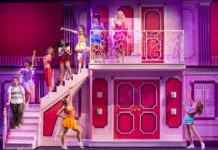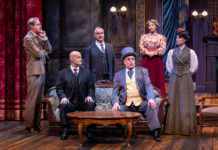This post contains affiliate links and our team will be compensated if you make a purchase after clicking on the links.
In the Heights tells the universal story of a vibrant community in New York’s Washington Heights neighborhood – a place where the coffee from the corner bodega is light and sweet, the windows are always open and the breeze carries the rhythm of three generation of music. It’s a community on the brink of change, full of hopes, dreams and pressures, where the biggest struggles can be deciding which traditions you take with you, and which ones you leave behind.
The Washington Post said IN THE HEIGHTS is “pure Broadway. An evening of old-style, innocent pleasure.”
If you can imagine Do the Right Thing mellowing out, learning Spanish, and bursting frequently into song, you’d get near In the Heights. This musical is a fond portrait of a New York neighborhood, in this case a Latino corner of Washington Heights bounded by the 181st Street A-train stop and the G.W. Bridge. Stories in such communities have been very good to American theater (Puerto Ricans, West Side), but no one’s going to mistake this show for its celebrated predecessor.
The most obvious of the show’s many virtues is that it doesn’t sound like the typical Broadway musical. Miranda’s score is rich and multicolored, as it needs to be. People on the block hail from all over: Cuba, the D.R., Mexico, Puerto Rico. As these immigrants and children of immigrants dream about returning to distant lands, or just going to the East Village, Miranda fills the stage with salsa and merengue. He also makes one of the most sophisticated theatrical swoop into that untapped lyrical, hip-hop. Usnavi runs a beaten-down bodega, dishing out café con leche, a very lucrative lottery ticket, and propulsive rhymes about wanting to go “from poverty to stock options.”
Lin-Manuel Miranda is the funny, irrepressible, Tony Award-winning composer and lyricist, which he initially conceived while studying at Wesleyan University.
That clever craftsmanship shapes many of the numbers. Songs slip into one another, advancing plot and shifting mood. Their sharp comedy is one reason why Miranda’s lyrics are some of the best that New York has heard from a young songwriter since Avenue Q. But his messy words are deeply evocative. Any quotes would wither on the page, so you’ll have to trust me that when Abuela Claudia sings about the open Cuban sky, or Vanessa describes a train rumbling by her apartment, or Nina remembers feeling that she lived at the top of the world when the world was just a subway map.
Rounding out this wonderful production is the one piece set that takes on a life of its own during the show. The three businesses ( Usnavi’s bodega, Rosario’s Car Service and Daniela’s Salon) look as if they were lifted right out of a New York neighborhood. Above are apartments with small balconies whose walls become transparent at times with the George Washington Bridge in the background. The lighting design is absolutely wonderful. Andy Blankenbuehler’s choreography, while at times seems a bit repetitive, keeps the cast moving and is the most impressive during the club scene at the end of act one which the cast executes it wonderfully.
Discover more from Socalthrills.com
Subscribe to get the latest posts sent to your email.











